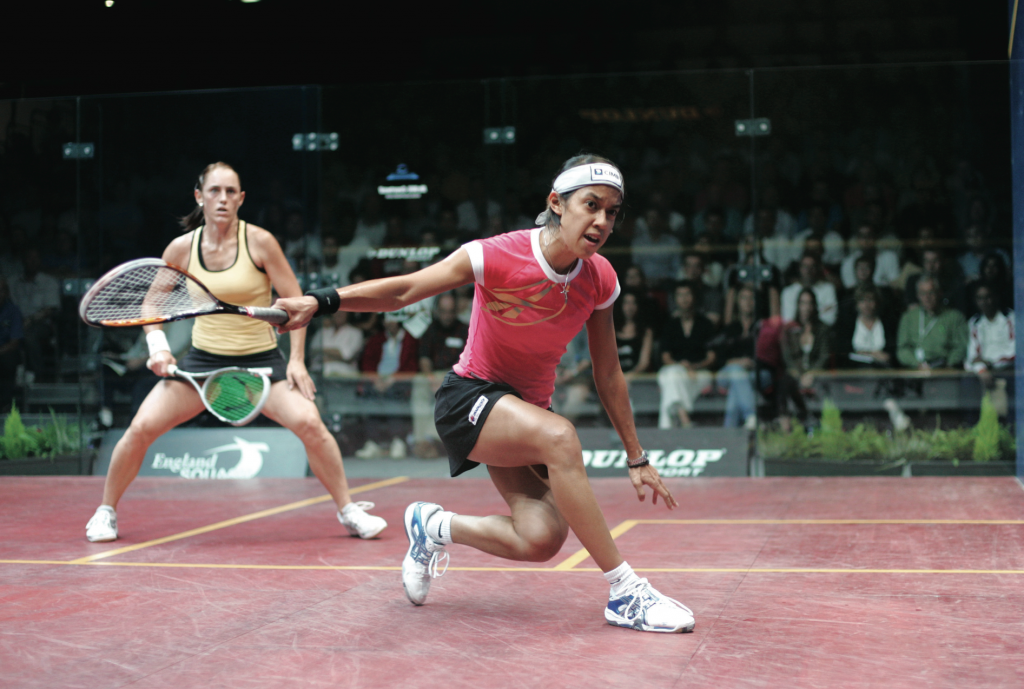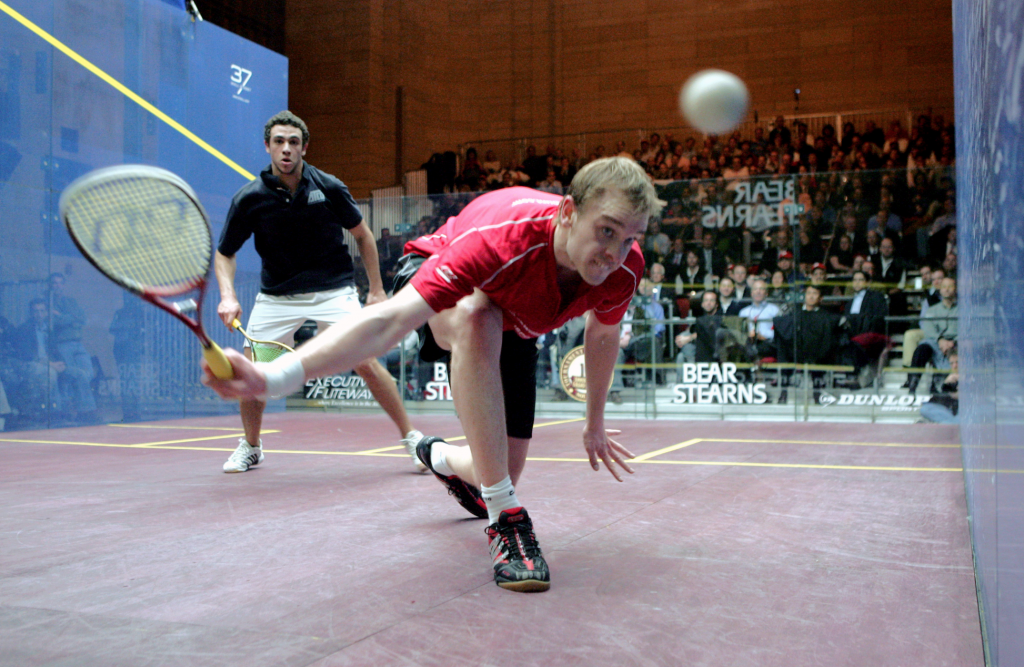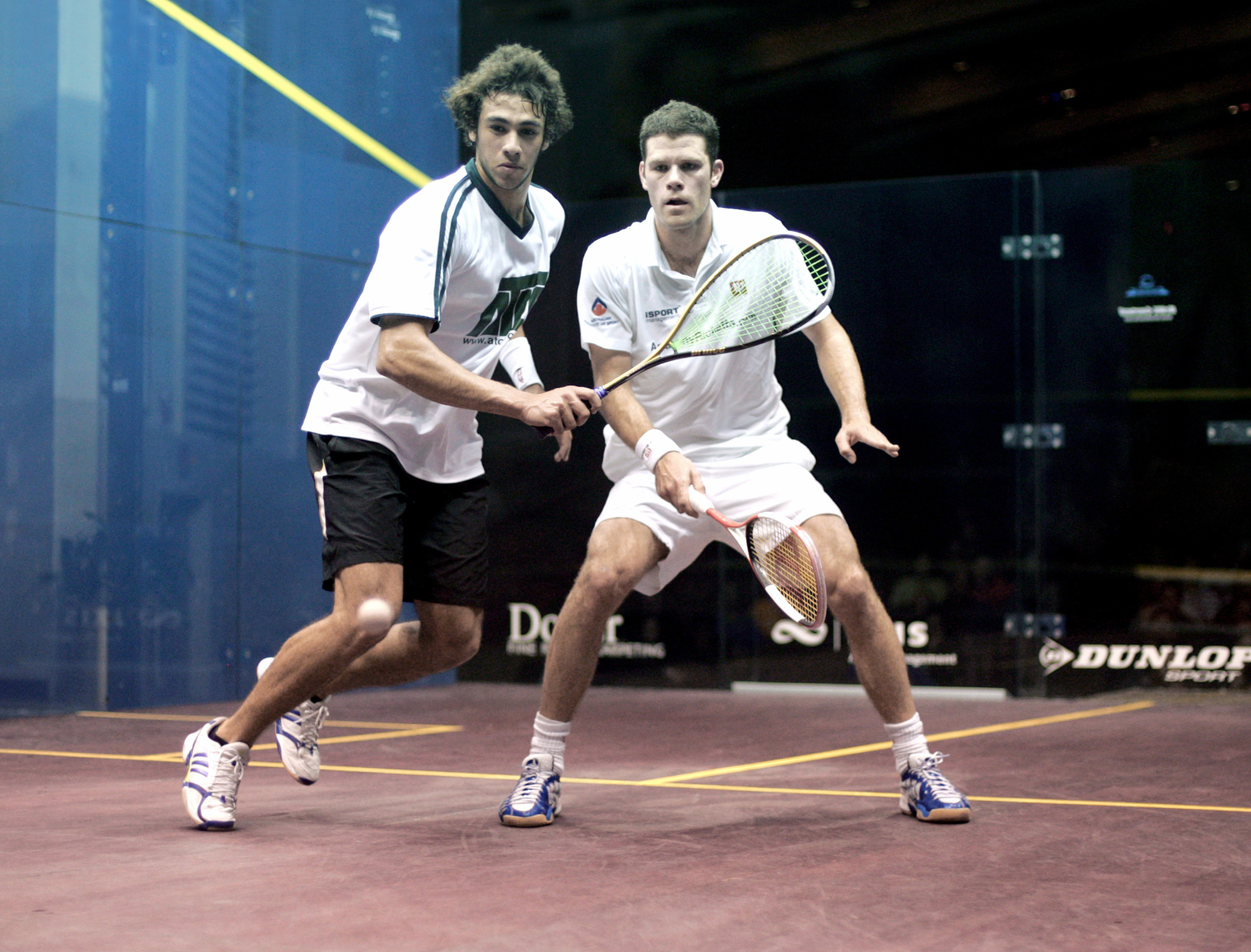By Richard Millman, Director of Squash, Kiawah Island Club
If you are like most players you probably have several phrases that ring out in your mind as classic pieces of lore, if not outright law, in the development of your game.
Most of us have echoes in our heads of either a friend or coach who repeatedly drilled the same few phrases into us. Either that or you might have picked up certain ideas as commonly held beliefs in the game.
Trouble is, two or three of those commonly held and repeated beliefs have done more damage to the development of squash than would have been done if nothing had been said at all!
Allow me to explain. In this and next month’s article I’m going to deal with the three that are probably most common:
1. “Get back to the ‘T’”—culprit number one and probably the worst.
2. “Keep your racquet up”—not as dangerous as number one, but responsible for more beginner and intermediate players looking loony than any other single piece of advice.
3. “Keep your eye on the ball” or “Watch the ball”—a pair of righteous remarks that prevent more beginners and intermediates from developing than almost any others.

Hopefully I have your attention now. But hold on-—before you go and shoot yourself—let me explain further. It’s not that these comments are totally wrong—they are just incomplete—and standing on their own, without proper explanation, they do more harm than good!
That’s often the trouble with tidbits of information that contain some truth—it’s so easy to mismanage them.
So let’s explore. Take number one: ‘Get back to the T.’ It sounds innocuous, doesn’t it? Common sense, you might say. Poison! That’s what I say! You see, as you may have heard from me before, a player’s relationship with the ball is sacrosanct. Nothing must interfere. Without total “oneness” with the ball, any unguarded moment where a player’s mental, physical and emotional focus is elsewhere, is a moment of ultimate vulnerability.
And the effects of that rotten old comment, ‘Get back to the T,’ are so reekingly full of vulnerability it almost beggars belief! Let’s check them off:
1. At the very moment the opponent is going to hit the ball—you are instructed to focus your primary attention on a piece of static red paint.
2. Because the advice sounds so authoritative—when you get there you feel you have completed a task—you shut down, when you should be on maximum alert!
3. The comment is often shouted after the player has hit the ball—thereby producing a knee-jerk reactive response—void of all proactive organizational planning and completely failing to promote understanding. Instead it produces an unknowing blind faith response based on somebody else’s logic base and requiring zero cerebral activity.
In other words, if you were an evil racquetball player, who felt threatened by the sport of squash (they don’t by the way—they are quite happy and frequently play both sports without feeling the least bit threatened by us) and wanted to sabotage squash, you would have to go a long way to find a better weapon than the insidious ‘Get back to the T.’
How then do we change this piece of ancient squash lore from a danger to a value? Easy! By giving the complete explanation that: When positioning ourselves on the court, we need to organize our shot and movement simultaneously to ensure that, without losing our primary focus on the ball, we situate ourselves geographically and temporally at the center of the opponent’s available range of return options.’

Not as sexy as, ‘Get back to the T,’ I grant you—but it educates the listener as to what their objective is. The trouble with quick glib pieces of advice is that they usually require little thought on the part of the student—just obedience.
But we’re not training dogs.
Additionally such comments often unwittingly misdirect the student’s focus and eclipse the original purpose of the advice.
We should be training and learning to be intelligent athletes who think for ourselves. Unless we fully understand what we are doing and why, we will never function effectively. Don’t follow advice blindly—no matter who or where it comes from. Think it through!
Number two: ‘Keep your racquet up’—is often downright funny in addition to being completely misunderstood. I can’t tell you how many times I’ve walked past a squash court and seen an otherwise perfectly sane player holding their racquet bolt upright, apparently preparing the biggest forehand in the history of the world, despite the fact the opponent hasn’t even hit the ball yet! When questioned as to why they were holding the racquet a mile above their head—they usually say something like, “I was keeping the racquet up!” as if this was an explanation in itself. On further investigation it usually turns out that they have heard the phrase ‘Get the racquet up’ so many times that it is now an involuntary response. One can’t help wondering if they spend the greater part of their day in the office like that—frightening the rest of the staff looking like a human hat stand!
So how do we stop ‘Get the racquet up’ from being dangerous and make it valuable?
By explaining that the so-called “preparation” in squash, isn’t just used to enable one to “hit the ball”—but is the very root of all planning and organization in the game and that by using early ‘preparation,’ which is in fact an extraordinary example of extremely precise hand-eye coordination, we are able to gauge exactly how far from the ball to run and also how to target our intended shot—considerably before we arrive at the ball. We therefore learn to think ahead of the game, developing strategy and creating time.

Again, not as juicy as ‘Get your racquet up!’ but requiring some vestige of intellect on the part of the student rather than a response to a sharp bang on the head!
Next month: “Keep your eye on the ball!” Kick that thought out of your head!
Skill Level Tips
Simple practice tips for 3.0, 4.0 and 5.0 players
3.0 Last month, in my Ghosting article, I explained how Ghosting helps develop an innate sense of the court in players. See if you can stop thinking about the ‘T’ as a particular spot to arrive at and learn to ‘feel’ your way to the center of the court by knowing where you are in relation to the ball first and the walls of the court second. This way the ‘T’ will cease to be a distraction that competes with the ball for your focus and will become somewhere that you naturally situate yourself at, in the course of your relationship with the ball.
4.0 To develop your ability to track the ball with your imagination: Have a partner hold the ball directly in front of you, approximately four feet away.
Then have the partner gradually move the ball around you until it is directly behind your head. Keep your eyes fixed on the ball’s original position but (without moving your eyes) keep your concentration on where the ball is as the partner moves it. Eventually your concentration and imagination should be focused on the ball behind your head, while your eyes are still fixed straight ahead of you. Relate this to the LessonCourt description of retrieving a difficult ball out of the back corner.
5.0 Practice the separation of visual focus (eyes) and mental focus (imagination) by doing the following drill: Stand parallel to the back line of the service box, facing the back wall on your backhand side. Visualizing the backhand sidewall as it progresses to the front wall, set yourself up to hit a backhand in the opposite direction to where you are facing. Throw the ball against the wall, then hit your shot. Watch it only when you hit it and thereafter track it with your imagination for about one or two tenths of a second. Then, look round to see it come back. If you can, hit it again and again (still facing the back wall) until you can continuously play it back to yourself without watching it go to the front wall.


